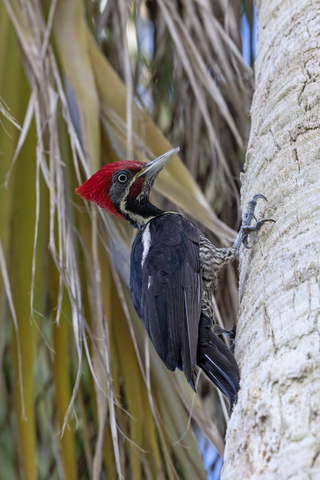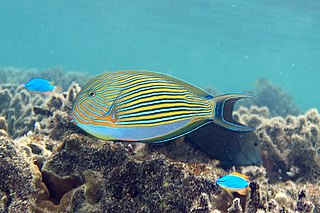
The lineated woodpecker is a very large woodpecker which is a resident breeding bird from southern Mexico to northern Argentina and Trinidad in the Caribbean.

The lineated barbet is an Asian barbet native to the Terai, the Brahmaputra basin to Southeast Asia. It is a frugivore and nests in holes of tree trunks.

Pandæmonium is the capital of Hell in John Milton's epic poem Paradise Lost.

The white-lined broad-nosed bat is a bat species found in southern and eastern Brazil, Paraguay, Uruguay, northern Argentina, Bolivia, Peru, Ecuador, Colombia, French Guiana and Suriname.

The lined catshark or banded catshark is a species of catshark, belonging to the family Scyliorhinidae. It is found in the waters off the coasts of Beira, Mozambique, to East London, and South Africa between latitudes 19°S and 31°S, from the surface to 290 m. It can grow up to 56 cm in length.

Lithodytes is a genus of frogs in the family of Leptodactylidae. It is monotypic, being represented by the single species, Lithodytes lineatus, also commonly known as the gold-striped frog or painted antnest frog. It is found in tropical South America where it lives in humid forests among the leaf litter. These frogs build foam nests at the edge of temporary pools, and the tadpoles develop within these. The frogs also associate with certain leafcutter ants and breed inside their nests without being attacked by the ants.

Acanthurus lineatus, the lined surgeonfish, blue banded surgeonfish, blue-lined surgeonfish, clown surgeonfish, pyjama tang, striped surgeonfish, and zebra surgeonfish, is a species of marine ray-finned fish belonging to the family Acanthuridae, the surgeonfishes, unicornfishes and tangs. This species is found in the Indo-Pacific region.

Euthynnus lineatus, the black skipjack tuna or black skipjack, is a species of ray-finned bony fish in the family Scombridae. It belongs to the tribe Thunnini, better known as the tunas.

Surface wave detection by animals is the process by which animals, such as surface-feeding fish are able to sense and localize prey and other objects on the surface of a body of water by analyzing features of the ripples generated by objects' movement at the surface. Features analyzed include waveform properties such as frequency, change in frequency, and amplitude, and the curvature of the wavefront. A number of different species are proficient in surface wave detection, including some aquatic insects and toads, though most research is done on the topminnow/surface killifish Aplocheilus lineatus. The fish and other animals with this ability spend large amounts of time near the water surface, some just to feed and others their entire lives.

Plotosus lineatus, commonly known as the striped eel catfish, is a species of eeltail catfishes belonging to the family Plotosidae. Like most other members of the genus Plotosus, they possesses highly venomous spines that they can use to sting when threatened. The venom can cause mild to severe symptoms in humans. P. lineatus is native to the Indo-Pacific but has become introduced to the Mediterranean via the Suez Canal as a Lessepsian migrant.
Alucita mulciber is a moth of the family Alucitidae. It is found in Costa Rica.

Erysichton lineatus, the hairy line-blue, is a butterfly in the family Lycaenidae. It is the sole species of the genus Erysichton. It was first described by Richard Paget Murray in 1874. It is found in New Guinea and along most of the eastern coast of Australia, from Queensland to New South Wales.

The red-shouldered hawk is a medium-sized buteo. Its breeding range spans eastern North America and along the coast of California and northern to northeastern-central Mexico. It is a permanent resident throughout most of its range, though northern birds do migrate, mostly to central Mexico. The main conservation threat to the widespread species is deforestation.

Homonoeini is a tribe of longhorn beetles of the subfamily Lamiinae. It was described by James Thomson in 1864.

Mulciber is a genus of longhorn beetles of the subfamily Lamiinae, containing the following species:
Paradoris mulciber is a species of sea slug, a dorid nudibranch, shell-less marine opisthobranch gastropod mollusks in the family Discodorididae.
Mulciber linnei is a species of beetle in the family Cerambycidae. It was described by James Thomson in 1864.
Mulciber pullatus is a species of beetle in the family Cerambycidae. It was described by Francis Polkinghorne Pascoe in 1867.
Mulciber rosselli is a species of beetle in the family Cerambycidae. It was described by Stephan von Breuning in 1970.













